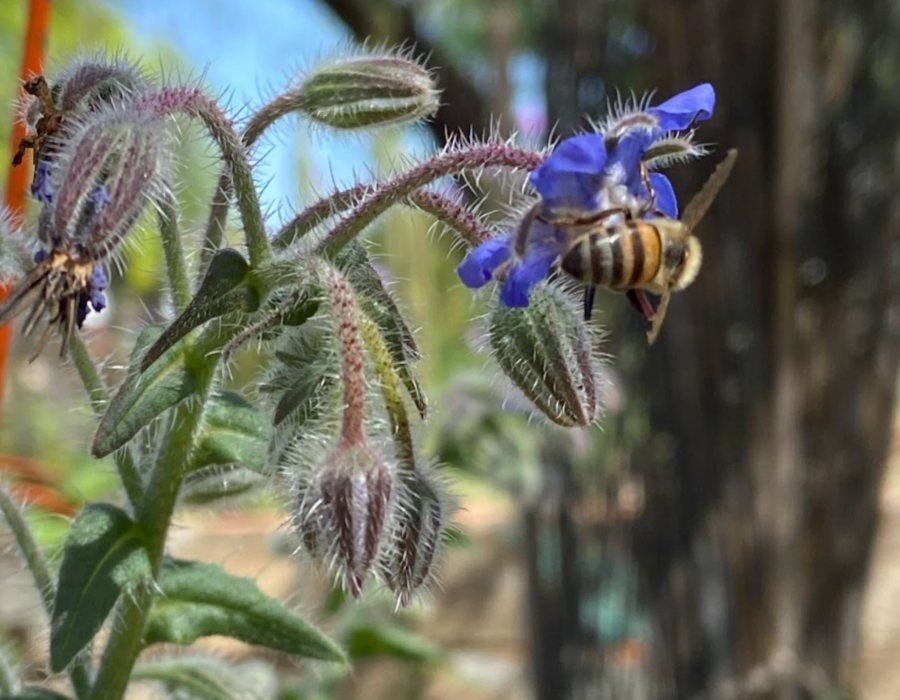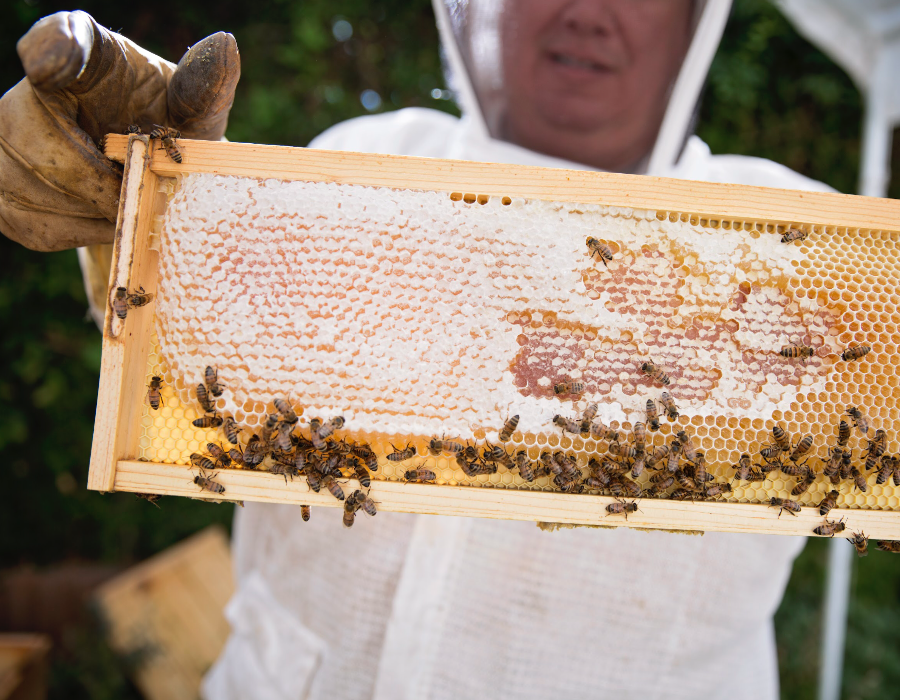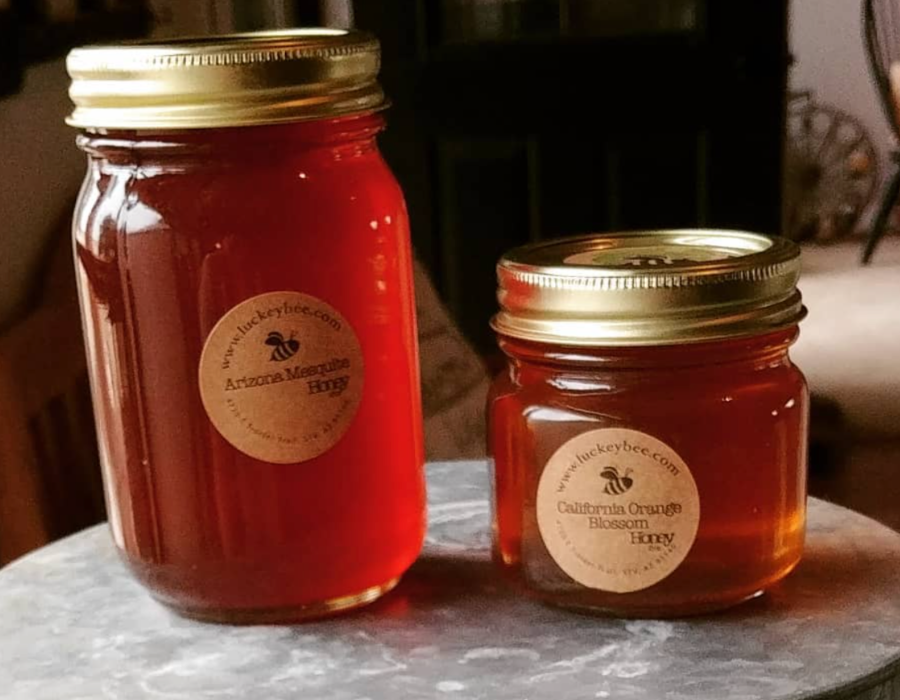By Joan Baron
Many researchers say that honeybees were introduced to Pacific Western America by way of Florida and eastern Mexico. The climate in our desert Southwest region is well suited for individuals seeking to learn more about bees and perhaps to even explore beekeeping. And whether your interest in bees is extensive or you have virtually none at all, one thing is for certain: Their role in our ecosystem is paramount to our survival. As such, our role is to protect and nurture them.
What to Plant to Help Our Bee Friends
We do this by planting pollinator flowers and vegetables every season to support them in growing their population — which helps to build a micro-ecosystem that supports all life. Examples are easy to find and grow in our dry, arid climate. Varieties such as cosmos, zinnias, sunflowers, luffa, lavender, marigolds, blanket flowers, lisianthus, four o’clocks, and peppers are all fabulous examples that can be easily planted in pots or garden beds at home.
 Bees are also drawn to flowers of the Moringa tree, citrus blossoms, and borage plants, which are readily available at most nurseries. A good tip: Be sure to focus your purchase on organic seeds or non-gmo seeds. This helps to protect the health and well-being of the bee during its short but busy life. Bee balm, echinacea, snapdragons, evening primrose, and California poppies are additional examples of colorful, bee-friendly plants.
Bees are also drawn to flowers of the Moringa tree, citrus blossoms, and borage plants, which are readily available at most nurseries. A good tip: Be sure to focus your purchase on organic seeds or non-gmo seeds. This helps to protect the health and well-being of the bee during its short but busy life. Bee balm, echinacea, snapdragons, evening primrose, and California poppies are additional examples of colorful, bee-friendly plants.
The Role of Bees in Agriculture
As pollinators, honeybees play a significant role in food production. When they dive into a blooming flower, they perform and roll around until their bodies are covered in pollen — but they don’t stop there. They’re onto the next flower until fully saturated, and they return to the hive to deposit their treasures. This intuitive and instinctive practice of transporting pollen onto other nearby plants culminates in food production. When the bees transfer pollen grains from the male anther of one flower to the female stigma of another, fertilization happens and fruits are created. We can all appreciate that some of our favorite foods grow as a result of this process of pollination. Without it we might not have those sweet strawberries, peas, beans, cucumbers, peaches, garlic, sunflowers, sweet potatoes, melons, and so much more to enjoy.
 We also benefit from their gift of fresh honey and beeswax produced in the beehives. Inside their hexagonal shaped homes or colonies, the queen bee stays busy laying eggs while the worker bees store the pollen and nectar — some for the larvae that will soon become drone or worker bees. Small hives can contain 20,000 bees, while larger hives can contain over 100,000! The many health benefits of honey — especially raw — include antioxidants, which makes honey a fantastic free-radical scavenger that protects healthy cells, in addition to being a terrific cough suppressant. Additionally, consuming local honey has been known to assist in the tempering of regional allergies. Other benefits that come straight from the hive include bee pollen, which provides important levels of vitamin A and vitamin C, calcium, and magnesium to support healthy bones. Bee propolis, a byproduct of the hive, has shown anti-inflammatory and anti-fungal properties, as well.
We also benefit from their gift of fresh honey and beeswax produced in the beehives. Inside their hexagonal shaped homes or colonies, the queen bee stays busy laying eggs while the worker bees store the pollen and nectar — some for the larvae that will soon become drone or worker bees. Small hives can contain 20,000 bees, while larger hives can contain over 100,000! The many health benefits of honey — especially raw — include antioxidants, which makes honey a fantastic free-radical scavenger that protects healthy cells, in addition to being a terrific cough suppressant. Additionally, consuming local honey has been known to assist in the tempering of regional allergies. Other benefits that come straight from the hive include bee pollen, which provides important levels of vitamin A and vitamin C, calcium, and magnesium to support healthy bones. Bee propolis, a byproduct of the hive, has shown anti-inflammatory and anti-fungal properties, as well.
How You Can Protect the Bees
Bees are vital to our survival and to be good stewards of the Earth requires that we protect the bees and understand Colony Collapse Disorder (CCD). Millions of bees have been wiped out in recent years due to pesticides such as Roundup and other agricultural chemicals and fungicides. A class of chemicals called neonicotinoids has been linked to bee deaths and is so serious that it has recently been banned in Europe. With its use, pollen gets contaminated from spraying fields in large farm settings and in neighborhood gardens. The best solution to this overwhelming problem is to build healthy soil through the use of organic food scraps and worms and planting cover crops such as clover, cow peas, buckwheat, sorghum, and other plants high in phosphorus and nitrogen to support energy production and plant growth, and to resist disease.
Another way that we can work to protect the bees is to make sure to leave hives undisturbed. If you ever discover a bee hive around your home or office, it’s best to seek out a professional who is skilled at relocating the hive.
According to Ernie Henson, owner of Lucky Bee Farm in San Tan Valley, “100% of wild bees in Arizona are Africanized. You won’t know how aggressive they are until you have contact.”
It’s important that we focus on hive relocation, not extermination, and leave it to the professionals to move and protect the thousands of bees that call a hive their home.
Ernie and his wife, Amy, are skilled at offering bee rescue and relocation services around the East Valley. Because they are also beekeepers, they make every attempt to save the hive, the bees, and their honey by bringing them back to their small family farm.
As Ernie puts it, “We appreciate the role of honeybees to our ecosystem, so we come prepared with a white beekeeper’s box to collect the bees, protect the hive, and the queen. We realize that one-third of our food comes from the work of these small pollinators.”
At one time, Ernie and Amy had 11 hives in their backyard in Gilbert. Their neighbors were especially appreciative because they had the sweetest and most consistent citrus production and abundant flowers due to the work of the Hensons’ pollinating bees.
Other important tips from Henson include not using pesticides or herbicides on our lawns and gardens and to be more aware of the needs of bees.
“Dandelions, for example, are considered by many to be a weed. However, they are the first source of food that bees seek out after the winter season.”
Additionally, because honeybees require water to cool the hive through evaporation and to maintain osmotic homeostasis, it can be helpful to set out shallow water dishes to assist in this process.

Education Is Key
Our world is a complex tapestry of life and thanks to bees, we are provided with a crucial service that pollinates millions of acres of crops, thereby improving biodiversity and preserving the sustainability of our agricultural system. To learn more about these special insects, check out documentaries like “The Secret World of Bees” or “The Pollinators,” directed by Peter Nelson.
“If too many bees die too quickly, the entire food supply chain is imperiled,” he says.
Nelson assures us that in time, we will enter a world that emphasizes the importance of our role in creating a biodiverse habitat for the bees to do their work.





